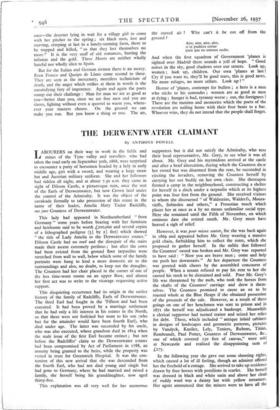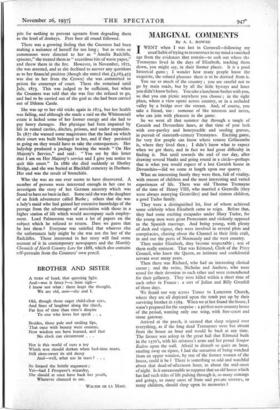THE DERWENTWATER CLAIMANT
By ANTHONY POWELL
LABOURERS on their way to work in the fields and mines of the Tyne valley and travellers who had taken the road early on September 3oth, 1868, were surprised to encounter a party of horsemen headed by a lady in early middle age, girt with a sword, and wearing a large straw hat and Austrian military uniform. She and her followers had ridden all night, and at about 7.30 a.m. they came in sight of Dilston Castle, a picturesque ruin, once the seat of the Earls of Derwentwater, but now Crown land under the control of the Admiralty. It was the object of the cavalcade formally to take possession of this estate in the name of their leader, Amelia Mary Tudor Radcliffe, suo jure Countess of Derwentwater.
This lady had appeared in Northumberland " from Germany " some years before bearing with her furniture and heirlooms said to be worth Lzoo,000 and several copies of a lithographed pedigree (31 by 21 feet) which showed " the title of Lady Amelia to the Derwentwater estates." Dilston Castle had no roof and the disrepair of the stairs made their ascent extremely perilous ; but after the cows had been evicted from the ground floor tarpaulins were stretched from wall to wall, below which some of the family portraits were hung to lend a more domestic air to the surroundings and also, no doubt, to keep out the draughts. The Countess had her chair placed in the corner of one of the less time-worn rooms on an upper floor, and almost her first act was to write to the vicarage requesting active support.
This disquieting occurrence had its origin in the earlier history of the family of Radcliffe, Earls of Derwentwater. The third Earl had fought in the 'Fifteen and had been executed. It had been proved by a marriage settlement that he had only a life interest in his estates in the North, so that these were not forfeited but went to his son (who but for the attainder would have been fourth Earl), who died under age. The latter was succeeded by his uncle, who was also executed, whose grandson died in 1814 when the male issue of the first Earl became extinct ; but not before the Radcliffes' claim to the Derwentwater estates had been compromised by Act of Parliament in 1788, an annuity being granted to the heirs, while the property was vested in trust for Greenwich Hospital. It was the con- tention of this new arrival that she was descended from the fourth Earl, who had not died young and single but had gone to Germany, where he had married and raised a family, she herself being his granddaughter, now aged thirty-five.
This explanation was all very well for her numerous supporters but it did not satisfy the Admiralty, who sent their local representative, Mr. Grey, to see what it was all about. Mr. Grey and his myrmidons arrived at the castle and after a brief altercation, during which the Countess drew her sword but was disarmed from the rear, he succeeded in ejecting the invaders, removing the Countess herself by carrying her out bodily on her own chair. She thereupon formed a camp in the neighbourhood, constructing a shelter for herself in a ditch under a tarpaulin which at its highest point was four feet from the ground. She received visitors to whom she discoursed " of Waldsteins, Waldecfs, Moura. vieffs, Sobieskis and others," a Proustian touch which places her at once as a by no means unfamiliar social type. Here she remained until the Fifth of November, on which ominous date she retired south. Mr. Grey must have heaved a sigh of relief.
However, it was pour mieux sauter, for she was back again in 1869 and appeared before Mr. Grey wearing a massive gold chain, forbidding him to collect the rents, which she proposed to gather herself. In the mêlée that followed the Countess' sword was broken and Mr. Grey was reported to have said : " Now you are brave men ; come and help me push her downstairs." At her departure the Countess was greeted with cheers by the assembled concourse of people. When a tenant refused to pay his rent to her she caused his stock to be distrained and sold. Poor Mr. Grey's life was threatened by the mob, who took the horses from the shafts of the Countess' carriage and drew it them- selves. The Countess promised to cause an ox to be roasted whole at the Blue Heaps if she obtained possession of the proceeds of the sale. However, as a result of these goings on one of her henchmen was sent to prison and in 1871 she herself was adjudicated a bankrupt. Meanwhile a clerical supporter had turned traitor and seized her relics for debt. These, which included " antique inlaid cabinets in designs of landscapes and geometric patterns, pictures by Vandyck, Kneller, Lely, Terriers, Rubens, Titian, Rembrandt, Paul Potter, Countess of Derwentwater, &c., one of which covered 15o feet of canvas," were sold at Newcastle and realised the disappointing sum of £275.
In the following year she gave out some shooting rights, which caused a lot of ill feeling, though an admirer offered her the freehold of a cottage. She arrived to take up residence drawn by four horses with postilions in scarlet. She herself was dressed in black and white satin and above her cloak of ruddy wool was a dainty hat with yellow streamers. Her agent announced that the miners were to have all the pits for nothing to prevent upstarts from degrading them to the level of donkeys. Free beer all round followed.
There was a growing feeling that the Countess had been making a nuisance of herself for too long ; but as writs or summonses were directed to her as " Amelia Radcliffe, spinster," she treated them as " scurrilous bits of waste paper," ' and threw them in the fire. However, in November, 1872, she was arrested, and as she declined to answer any questions as to her financial position (though she stated that L3,163,453 was due to her from the Crown) she was .committed to prison for contempt of court. There she remained until July, 1873. This was judged to be sufficient, but when the Countess was told that she was free she refused to go, and had to be carried out of the gaol as she had been carried out of Dilston Castle.
She was up to her old tricks again in 1874, but her health was failing, and although she made a raid on the Whittonstall estate it lacked some of her former energy and she had to pay heavy damages. Her physique had been impaired by life in ruined castles, ditches, prisons, and under tarpaulins. In 1,877 she warned some magistrates that the land on which their court was built belonged to her, and if they persisted in going on they would have to take the consequences. Her ladyship produced a package bearing the words " On Her Majesty's Service," and said : " You see by this letter that I am on Her Majesty's service and I give you notice to quit this court." In 188o she died suddenly at Shotley Bridge, and she was buried at Blackhill cemetery in Durham. Her end was the result of bronchitis.
Who she was no one ever seems to have discovered. A number of persons were interested enough• in her case to investigate the story of her German ancestry which was found to have no basis in fact. Some said she was the daughter of an Irish adventurer called Burke ; others that she was a lady's maid who had gained her extensive knowledge of the peerage from the advantages of association with those in a higher station of life which would accompany such employ- ment. Lord Palmerston was sent a lot of papers on the subject which he refused to return. Dare we guess that he lost them ? Everyone was satisfied that whoever else the unfortunate lady might be she was not the last of the Radcliffes. Those interested in her story will find some account of it in contemporary newspapers and the Monthly . Chronicle of North Country Lore for 1888, which also contains self-portraits from the Countess' own pencil.















































 Previous page
Previous page